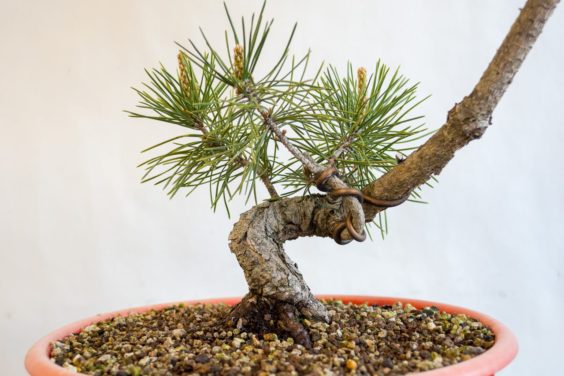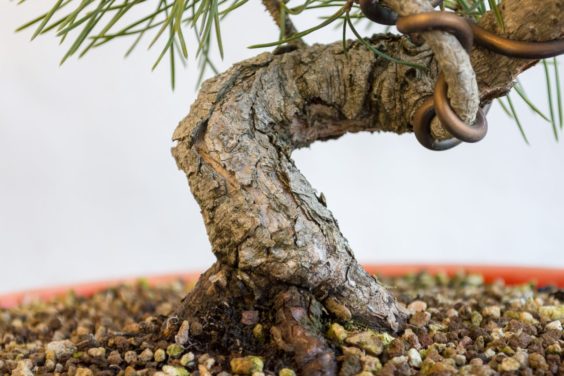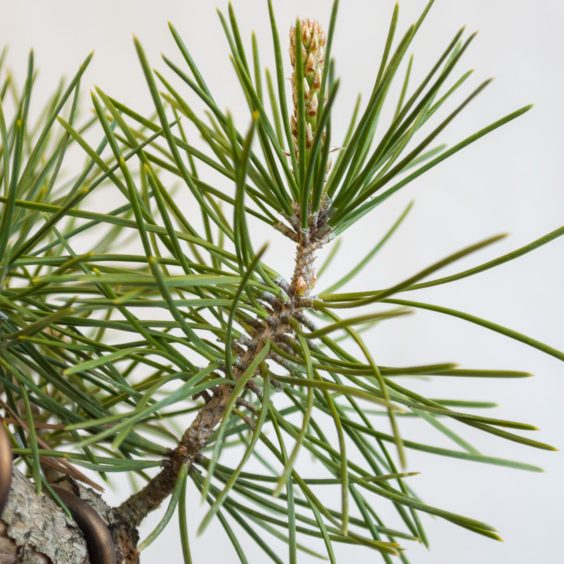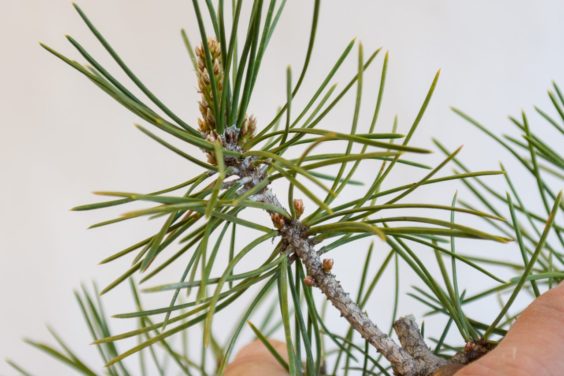Few trees in my garden better demonstrate the use of sacrifice branches than the pine below.
Black pine – six-years-old from seedling-cutting
The large branch that grows up and to the right is the sacrifice branch. The small tree at the base of this branch is the future bonsai.
The future bonsai
As I noted a few weeks ago, the definition of a sacrifice branch is simple: any branch used to achieve development goals that is not part of the final design. The most common reasons to use sacrifice branches are to thicken a section of the trunk or to close a large wound.
In the case of the pine pictured here, the goal of the sacrifice branch is to thicken the trunk.
Close-up of the trunk
The plan is to leave the sacrifice branch in place for a few more years until the lower section of the trunk reaches the desired thickness. In the meantime, I’ll encourage as much growth as possible on the sacrifice branch while maintaining the health of the lower branches that will be part of the future bonsai.
This is often easier said than done. Because the tree invests most of its resources in the sacrifice branch, the growth below is often weak.
The branch in the photo below is a good example of this. The top needles grew in 2017, the middle needles in 2016 and the lowest needles in 2015.
Three years of needles
As long as these needles stay healthy, I can create back buds with relative ease. If they brown out and fall off, I’ll need to graft if I want branches in that area.
How to keep these lower branches healthy? The main way is to occasionally reduce growth on the sacrifice branch to ensure the lower growth receives good sunlight. Not pruning, thinning, or decandling the lower branches can also help keep them healthy.
The pine pictured here appears to have a good ability to produce back buds. Looking closely at the lower branches reveals small buds that appear right where buds appear after decandling – just above the previous year’s growth. What’s interesting, in this case, is that these buds are growing in the zones just past needles that developed in 2015, and in the photo below, 2014! Even though the needles that developed in 2014 are long gone, new buds are appearing right where I’d expect them to grow had I decandled the tree three years ago.
Unprompted – and welcome – adventitious buds
These back buds aren’t uncommon on healthy, young pines, but I can’t count on them appearing when I need them so I try to preserve as many old needles as possible. There’s a good chance that this branch will become a sacrifice branch itself after I remove the current sacrifice branch, in which case these back buds may come in handy.
Subscribe to Bonsai Tonight
New Posts Delivered Every Tuesday and Friday





Josiah VanWagner says
thanks for sharing. i love your pine development posts. bonsai tonight is indispensable when growing jbp from seed.
Jonas Dupuich says
Thanks Josiah!
Philip Shimko says
Jonas what time of year do you remove sacrifice branches?
Thanks
Painter
Jonas Dupuich says
Good question – I usually remove sacrifice and other major branches in early spring or summer to encourage healing during the growing season.
Gordon kelsch says
Jonas can you talk about when and why you would decandle a plant in development like these?
Jonas Dupuich says
Good question Gordon – in general I don’t decandle trees like this. If the bottom branches get too weak, I’d consider dramatically cutting back or decandling the sacrifice branch. I might decandle the lower branches if they are strong, relative to the sacrifice branch, and/or I want more branch division.
My normal approach is to begin decandling when the trunk has reached the desired size and I’m beginning to reduce the sacrifice branch.
Alessandro says
Ciao Jonas! When you will cut the sacrifice branch there will be a big wound. That wound will recover with another sacrifice branch that will cause another wound…. and so on. Don’t you think that this kind of approch is taking too much time and too many scars on the tree?
Thank you, Alessandro.
Jonas Dupuich says
Hi Alessandro! I agree, this approach takes time and produces scars. I’d happily pursue an alternative approach – do you have any suggestions? I’m always looking for new ideas 🙂
Alessandro says
Ciao Jonas! Unfortunaly no, I do not know an alternative approach 😔, I was guessing if you follow another way in parallel to this. For sure the combination of sacrifice branch and colander do the best job.
Thank you again for sharing your knowledge with us!🙏
Alessandro
Jonas Dupuich says
Thank you Alessandro – I’ll keep trying to improve on the current approach and share whatever I can along the way. Thanks again!
Sergio Gapski says
Hi Jonas. If I am aiming a tall tree to do a literati bonsai what would you say is the best strategy, cutting the lower branches and let the top grows freely ( the “sacrifice ” branch) or leave some lateral branches to improve photosynthesis and maybe a faster growth? Thanks again!
Sergio from Brazil.
Jonas Dupuich says
Hi Sergio – great question! I’ve been starting to work on bunjin-style trees the past couple years. I don’t know the answer, but a few ideas come to mind. The best character in the trunk comes from time – growing the tree slowly will help with this. When it comes to sacrifice branches, using branches higher on the tree – closer to the apex – will thicken the tree without contributing to taper. Vigorous growth will produce larger trunks and branches whereas slower growth will produce thin branches.
In other words, getting the style mostly right is straightforward, but developing the character that we most appreciate in great bunjin bonsai will require time 🙂 Good luck!
Sergio says
Thank you, jonas. I would like to see a post about it! 😉
Cory says
Thank you for your wonderfully informative blog.
I have more of a general question- Are you getting these trunk sizes from growing in the colanders or other pots, or have these trees been field grown first?
Cheers,
Cory
Jonas Dupuich says
Thanks, Cory! These pines have been container grown, mostly in colanders.